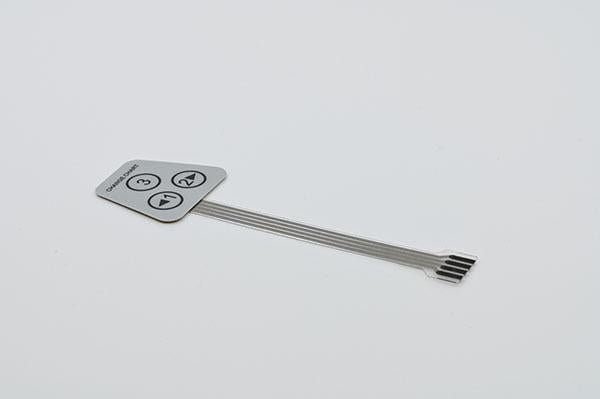Just How Membrane Layer Switches Contribute to the Toughness of Electronic Control Panels
Membrane switches play a vital duty in boosting the toughness of digital control panels, mostly with their multi-layered building which supplies reliable security versus ecological factors such as moisture and dust. The lack of moving components substantially decreases the possibility of mechanical failures, making membrane changes ideal for requiring applications.
Meaning of Membrane Layer Buttons

Membrane switches are developed to be slim and lightweight, making them appropriate for applications where room is limited. They can be manufactured in different shapes, dimensions, and shades, offering flexibility in style that meets visual and useful needs. In addition, membrane buttons can incorporate various innovations, such as responsive feedback and LED signs, improving individual experience.
Due to their construction, membrane layer switches are commonly immune to dirt, wetness, and general wear, adding to their sturdiness in requiring settings. Their smooth style not only promotes easy cleansing but also reduces the risk of mechanical failure, making them a favored selection for producers seeking trustworthy individual interfaces in their electronic control board.
Defense Versus Ecological Factors
The design of membrane layer switches naturally offers a degree of security versus different environmental aspects, which is vital for keeping capability in challenging problems - Membrane Switch. These switches are normally built with layers of versatile materials that secure inner elements from moisture, dirt, and pollutants. By encapsulating the wiring, membrane switches reduce the threat of brief circuits and corrosion, which can substantially impair efficiency
In addition, using durable adhesives and sealers during manufacturing enhances their resistance to ecological challenges. Membrane layer buttons can sustain direct exposure to chemicals and solvents, making them appropriate for industries such as food handling and healthcare, where health and tidiness are extremely important. Their seamless surface area design also stops the accumulation of dust and microorganisms, helping with simpler cleansing and upkeep.
Temperature level fluctuations are another ecological concern, and membrane switches are engineered to work effectively throughout a wide variety of temperatures (Membrane Switch). This flexibility makes sure that control board remain operational in numerous settings, from commercial settings to customer electronics
Effect On Individual Interaction
User communication with electronic control panels is dramatically affected by the layout and functionality of membrane layer switches. These buttons supply a tactile interface that improves the overall user experience, enabling instinctive navigation and control. Their receptive nature guarantees that individuals receive instant comments upon activation, which is critical for jobs calling for accuracy and efficiency.
Furthermore, the smooth surface area of membrane changes facilitates very easy cleansing and maintenance, advertising customer confidence in the integrity of the user interface. This tidiness is especially important in settings where hygiene is paramount, such as clinical or food handling settings. Additionally, the portable and light-weight layout of membrane changes adds to the aesthetic charm of control panels, encouraging individual engagement through a modern and streamlined appearance.
In addition, the assimilation of visual elements, such as printed symbols and backlighting, aids individuals swiftly recognize features, lowering the learning contour connected with brand-new equipment. Because of this, customers can run gadgets a lot more effectively, resulting in increased performance and contentment. In summary, membrane buttons play an essential duty in enhancing individual interaction by integrating capability, looks, and ease of usage, ultimately causing improved functional performance.
Design Adaptability and Customization
Layout adaptability and modification are important elements of membrane buttons, enabling suppliers to tailor digital control board to details applications and click here now individual needs. This flexibility permits the combination of different layout elements, such as shades, graphics, and textures, which can enhance the aesthetic appeal and individual involvement of the control panel.
Membrane layer switches can be tailored in dimension and shape, suiting a wide variety of tools and applications, from commercial machinery to customer electronics. This adaptability makes certain that producers can produce instinctive interfaces that line up with customer expectations and functional demands. In addition, the capability to include unique functions such as backlighting or tactile responses better improves functionality, enabling an extra interactive experience.
Additionally, the manufacturing process for membrane switches over supports the quick prototyping of designs, enabling makers to iterate and refine their principles rapidly. This capacity not only speeds up the growth timeline however likewise ensures that the final product satisfies details functional and aesthetic requirements.

Cost-Effectiveness and Durability
Cost-effectiveness and long life are significant advantages of membrane buttons, making them an attractive choice for producers and end-users alike. These switches are typically less costly to generate than traditional mechanical switches, primarily because of their simplified manufacturing processes and the lowered variety of components required. This expense benefit extends not only to first manufacturing however likewise to long-lasting operational expenses, as membrane buttons often need much less upkeep and have a lower failure price.
Additionally, the longevity of membrane layer switches adds to their general worth. Constructed from durable materials, they are immune to ecological aspects such as moisture, dust, and chemicals, which can bring about early wear in other button kinds. The absence of relocating components minimizes mechanical failing, allowing membrane switches over to preserve capability over prolonged durations.
This toughness is particularly helpful in applications requiring constant efficiency under requiring conditions, such as medical tools and industrial equipment. Eventually, the mix of cost-effectiveness and long life makes membrane layer changes a financially practical selection for producers, giving reliable solutions that stand up to the examination of time while maximizing monetary considerations.
Conclusion
In verdict, membrane layer buttons substantially visit this page improve the toughness of electronic control panels through their durable building and safety features - Membrane Switch. Generally, membrane changes represent he has a good point a dependable and economical choice for improving the durability and capability of electronic control systems.